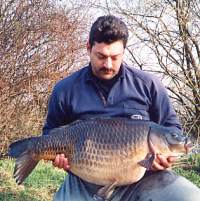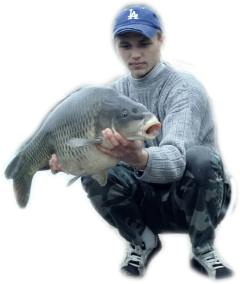Big Rik Belenger is better known as ‘Carp Angler’ on the FISHINGmagic Forum, where he is appreciated for his generous help to all and sundry. He has now extended that help with a regular carp fishing column for FISHINGmagic, ‘Big Rik’s Carp Column’.
Rik started fishing at the age of four on his local tiny tidal river, catching eels and small wild trout on worm. 
Not having had any angling family members, all his early fishing was solitary and this seems to have carried through to the present.
Like most anglers nowadays, he has a full time job and a family, so his fishing time is limited, although he does, he tells us, have a very understanding wife.He currently lives in the depths of Hampshire, and so is within easy reach of some excellent venues.
He has in the past, and still does, fish for most species, although his greatest love is for carp fishing, which is how the majority of his time is spent.
He now finds himself more thrilled with overcoming the intricacies and problems associated with catching carp, rather than the actual weight of the fish he catches and the so-called glory that goes with it.
Locating Carp
It’s often been said and written that location is the most important factor when attempting to catch carp. But location is less important on well-stocked venues and when the water temperature is high. It is when we move onto waters with a lower stock density that location plays a much more vital role.
In this article I’ll be focusing on margin fishing.
What are the advantages of fishing in the margins?
Normally, you can see, or will have seen, fish in a certain spot. And this is better than casting to a distant feature that you think the fish may be near. You will only spot carp in the swim if you approach it with stealth, but this I will come to later in the article.
Another plus point is that you can bait up accurately and quietly using baits and attractors that are different to the norm. And the ability to place your rig, knowing it isn’t tangled and without a big splash, is another major plus.
So with all these advantages why do so few people fish the margins? Because it can be very hard work! 
So how do we go about it?
Most of us who know the lake we are fishing reasonably well, will probably be forming an idea of the swim we want to fish on our journey there, using pointers such as wind strength and direction, temperature, previous success etc, etc.
This is brought about by the rush for swims on Friday afternoons when work kicks out and I know this is a necessity for some to grab a swim before the lake fills up.
What I’ve done in the past is to get to my pre-chosen swim and, if it’s safe to do so, leave the gear and go looking around the lake.
Now it gets harder, we have to make stealthy, quiet movements and concentrate.Try to wear clothes that blend in; dark greens, browns and black, it doesn’t have to be camo gear. Also needed are Polaroid’s and a cap or other hat with a peak to shade the eyes.
Tread lightly and try to keep concealed, keep off of the skyline and creep or crawl and look into likely looking spots. Obvious spots are bushes, trees, snags, pads, drop-offs etc. but these could be as devoid as your distant mark, so what are we looking for?
Fish feeding hard with their tails out of the water would be nice, but this happens very rarely and normally, according to Sod’s Law, when you haven’t got your gear.
Bubblers are a good indication, but don’t just rush and grab your gear, watch the bubbles and see if the fish are moving in any particular direction.
Trying to spot fish can be difficult unless the shadows and sun are in your favour, pick a spot to look at and concentrate on it, after a short time, you will tend to be able to pick out the clearer patches and any movement over them can then be easily seen.
Slight movement of weeds and lilies can also be difficult to spot unless you’re looking directly at them, but once you are concentrating, then any slight movement will be noticed and a swirl, boil or reed stem knock can often be noticed out of the corner of your eye.
Dirtied water or clouds of silt being disturbed, or oils and air being disturbed out of the silt and mud are signs of fish activity. Another good, yet mostly ignored, indicator that carp are in the swim is the reaction of the waterfowl. In my experience, coots seem to feed on the same things as carp: bloodworm, crustaceans, left-over bait, etc.
Now, diving coots may give you an indication of a feeding spot, but not necessarily that there are carp in the swim, this is where you need to concentrate on their activity. A coot will dive for a regular duration to a feeding spot, the length of time under the water will be determined by the depth and the food source. If a group of coots are diving for say, 8 to 10 seconds and then one resurfaces after a second or two, then there is a reason for this. 
They will surface, usually complaining, and will look at the water and be agitated. Now I know they don’t surface shouting “carp, carp, carp”, but 6oz roach don’t scare coots, big fish do.
It may not be much to go on, but sometimes it could be your only sign.
Right, we’ve found some feeding fish, now what do we do?
Firstly, don’t come running into the swim, drop your gear and immediately start bashing in bivvy pegs.
If possible, ready your gear behind the swim. This is where rod pods come into their own, you can move to the waters edge, gently place the pod down, flick your rod out, place it on the pod and slowly retreat back from the edge.
What baits to use
You can use standard baits in the margins, but because you are not restricted by distance you can use and apply many different forms of bait.
Boilie crumb
This is made using a blender or grinder to produce a fine crumb that you can lightly squeeze into small balls that will provide a carpet of almost inedible bait that will leak flavour and drive the carp mad.
Small seed particles
My favourites are pigeon conditioner, wild bird food, groats, hemp, and dari seeds, not forgetting to add condensed milk to give a fantastic cloud effect.
Pellets
I’ve had good success using Hinders 3mm Hi-betaine, not too many though as it does seem to pre-occupy them.
Soups
Soups are fantastic. I liquidise sweetcorn, luncheon meat, hemp and add hemp oil, molasses and water to create an attractant that stays suspended at all depths giving off major food signals.
I’ve also used watered down boilie mixes to good effect. 
Groundbaits
All manner of groundbaits are good for carp, especially pellet type mixes and fishmeal based ones.
All these loosefeeds can be applied by hand or with the use of a groundbaiting spoon such as the one made by Cobra. This particular piece of kit I find invaluable for margin fishing and I use it on a 12ft extending landing net handle.
It is one of the few ways you can apply the soups, but it also means that you can drop your rig and loose feed into the cup and place it exactly on your marginal spot. This accentuates accurate placement and also minimises disturbance.
Standard end rigs will suffice, but the use of slack lines, back leads and light indicators will create a less suspicious situation for the carp. Slack marginal lines also mean fewer pick-ups from the wildlife, and we could all do with less of those.
You might find a marginal area that the carp frequent, but it may be impossible to present a bait to them, due to weed etc. In this situation, one trick I’ve employed in the past on a few different waters is to create my own marginal spots.
This could be as simple as raking the margins with a weed rake, or better still, getting in there with a garden hand rake. On some occasions I’ve taken a barrow of gravel and spread it into the margins to create a new spot.
Whatever water you fish, the margins represent the biggest feature and greatest allure for the carp.
Stay quiet and unobtrusive and you too could reap the rewards.










